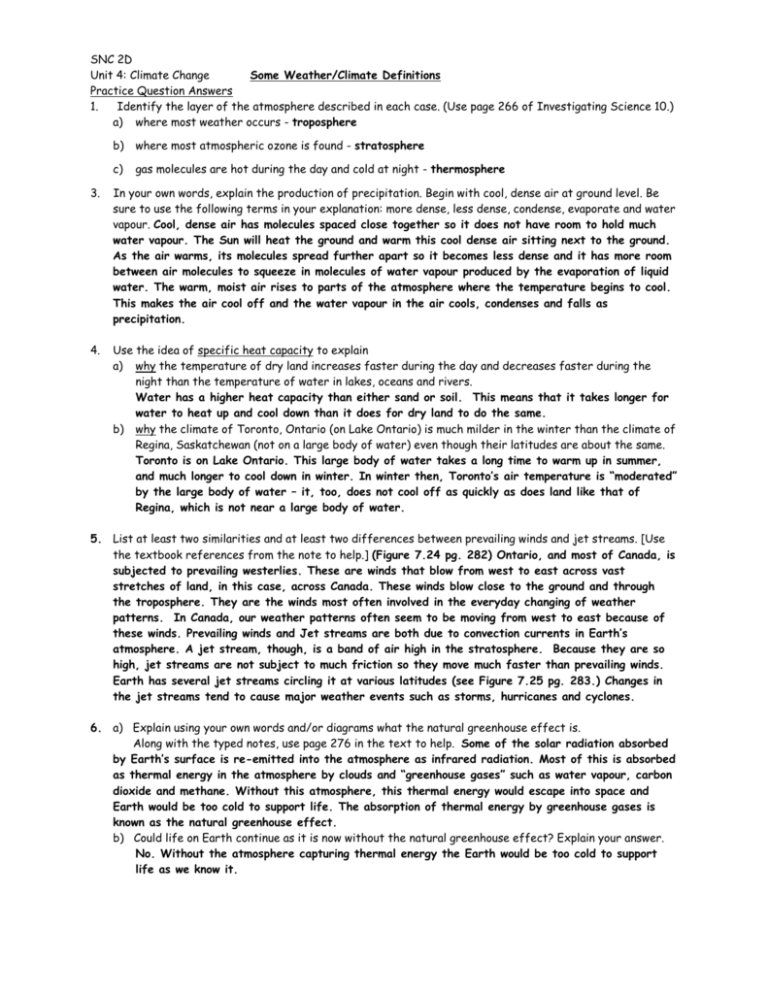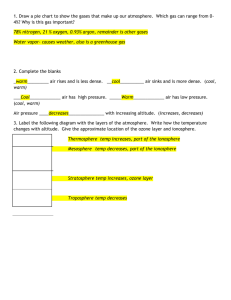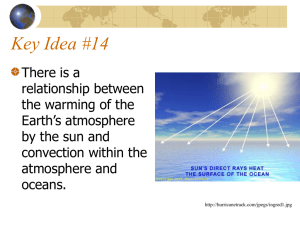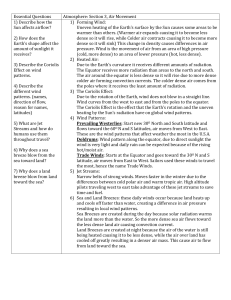SNC 2D Unit 4: Climate Change Some Weather/Climate Definitions
advertisement

SNC 2D Unit 4: Climate Change Some Weather/Climate Definitions Practice Question Answers 1. Identify the layer of the atmosphere described in each case. (Use page 266 of Investigating Science 10.) a) where most weather occurs - troposphere b) where most atmospheric ozone is found - stratosphere c) gas molecules are hot during the day and cold at night - thermosphere 3. In your own words, explain the production of precipitation. Begin with cool, dense air at ground level. Be sure to use the following terms in your explanation: more dense, less dense, condense, evaporate and water vapour. Cool, dense air has molecules spaced close together so it does not have room to hold much water vapour. The Sun will heat the ground and warm this cool dense air sitting next to the ground. As the air warms, its molecules spread further apart so it becomes less dense and it has more room between air molecules to squeeze in molecules of water vapour produced by the evaporation of liquid water. The warm, moist air rises to parts of the atmosphere where the temperature begins to cool. This makes the air cool off and the water vapour in the air cools, condenses and falls as precipitation. 4. Use the idea of specific heat capacity to explain a) why the temperature of dry land increases faster during the day and decreases faster during the night than the temperature of water in lakes, oceans and rivers. Water has a higher heat capacity than either sand or soil. This means that it takes longer for water to heat up and cool down than it does for dry land to do the same. b) why the climate of Toronto, Ontario (on Lake Ontario) is much milder in the winter than the climate of Regina, Saskatchewan (not on a large body of water) even though their latitudes are about the same. Toronto is on Lake Ontario. This large body of water takes a long time to warm up in summer, and much longer to cool down in winter. In winter then, Toronto’s air temperature is “moderated” by the large body of water – it, too, does not cool off as quickly as does land like that of Regina, which is not near a large body of water. 5. List at least two similarities and at least two differences between prevailing winds and jet streams. [Use the textbook references from the note to help.] (Figure 7.24 pg. 282) Ontario, and most of Canada, is subjected to prevailing westerlies. These are winds that blow from west to east across vast stretches of land, in this case, across Canada. These winds blow close to the ground and through the troposphere. They are the winds most often involved in the everyday changing of weather patterns. In Canada, our weather patterns often seem to be moving from west to east because of these winds. Prevailing winds and Jet streams are both due to convection currents in Earth’s atmosphere. A jet stream, though, is a band of air high in the stratosphere. Because they are so high, jet streams are not subject to much friction so they move much faster than prevailing winds. Earth has several jet streams circling it at various latitudes (see Figure 7.25 pg. 283.) Changes in the jet streams tend to cause major weather events such as storms, hurricanes and cyclones. 6. a) Explain using your own words and/or diagrams what the natural greenhouse effect is. Along with the typed notes, use page 276 in the text to help. Some of the solar radiation absorbed by Earth’s surface is re-emitted into the atmosphere as infrared radiation. Most of this is absorbed as thermal energy in the atmosphere by clouds and “greenhouse gases” such as water vapour, carbon dioxide and methane. Without this atmosphere, this thermal energy would escape into space and Earth would be too cold to support life. The absorption of thermal energy by greenhouse gases is known as the natural greenhouse effect. b) Could life on Earth continue as it is now without the natural greenhouse effect? Explain your answer. No. Without the atmosphere capturing thermal energy the Earth would be too cold to support life as we know it. c) How is the natural greenhouse effect different from anthropogenic greenhouse effect? The anthropogenic greenhouse effect is the increase of the overall greenhouse effect as caused by human activity. For example, it is proposed that increased industrial growth has produced much more carbon dioxide now than was produced before the industrial revolution. This increase in the atmospheric levels of carbon dioxide gas has been caused by people and it may be causing the natural greenhouse effect to be enhanced beyond normal expectations. 7. a) How does Earth’s albedo today differ from the albedo 20 000 years ago, during the last glacial period? Explain your answer. Ice has a high albedo because it reflects light well. Thus, the albedo during a glacial would’ve been much higher than it is now. b) How might snowier winters slow global warming? More snow and ice could increase the albedo of the parts of Earth’s surface that they cover. This would increase the amount of sunlight reflected away from Earth’s surface and could therefore decrease overall temperature. 8. How can a volcanic eruption half way around the world affect weather in Canada? Volcanic eruptions put a great deal of smoke and ash into the air. The ash can act to deflect the Sun’s solar energy and decrease average global temperature. A decrease in temperature will then affect weather. 9. Fill in the blanks. a) The movement of ___tectonic plates____ affects the locations and shapes of continents and oceans. b) Some climate change may be _anthropogenic__ which means it is caused by human activity. c) _Winds___ are the movement of air from an area of higher pressure to an area of lower pressure. They are responsible for moving thermal energy via _convection currents_ through air on the Earth’s surface. d) A metal spoon is warmed by a fire. This is an example of transferring heat energy by __conduction____ . 10. The shifting of tectonic plates can produce mountain ranges. The presence of a mountain range can have a profound effect on the climate of the area on either side of it. Use the diagram below to explain why area A is likely to have a wet, moist climate compared to area B. …and its water vapour cools, condenses, forms clouds and falls as precipitation in area A. Warm, moist air becomes less dense so it rises. As it rises, the temperature decreases… Now the dry, cool air falls because it is more dense. As it moves along the ground it is heated up and becomes dry, warm air passing on this side of the mountain. Warm, moist air Mountains Area A Area B 11. List and describe at least 3 relationships between energy from the Sun and climate. Here are 3 options. There are many things you could choose. Here are six possibilities. The first 3 come from the “Earth and the Sun” section of the handout “Some Weather/Climate Definitions”. The last 3 come from putting together various bits of information originating on this same handout and in class discuassion. a) Changes in Solar Activity – Irregular fluctuations and a regular sunspot cycle are two factors that alter solar output. Many scientists believe that the variations these factors cause are the main reasons for climate change (more important than changes in CO2 levels in the atmosphere). b) Movements of Earth in Space – The Earth’s movement and tilt during that movement are key to determining where the most solar radiation is hitting the Earth’s surface and what time of year it is there. These factors are also key to establishing the seasons in North America. c) Changes in Earth’s Rotation, Orbit and Tilt – Small, repeating cycles of changes in Earth’s orbit, tilt and rotation change how the Sun’s rays hit different parts of Earth and help to explain climate changes over long periods of time. d) The net radiation budget = incoming solar radiation – outgoing radiation = 0. Any imbalance in this budget means that the average global temperature would be affected. If, for example, the atmosphere did not send as much solar radiation back into space as was coming in, the average global temperature would increase. e) Wind is the movement of air from areas of high pressure to areas of low pressure. The temperature of the atmosphere tends to increase in areas close to or at the equator because the Sun’s rays hit that area of Earth at such a direct angle. This means the air here becomes less dense and rises. In areas close to or at the pole, the temperature of air decreases and air falls. Along with these convection currents caused by the different patterns of warming of Earth’s surface by the Sun and the Coriolis Effect, Earth’s winds move the radiant heat around from the Equator to the poles and back again (see pg. 280 – 281). Winds have a major effect on the climate of an area. f) Heat from the Sun is transferred into water as well. The convection currents produced and the Coriolis Effect serve to move the thermal energy around the hydrosphere. (See pg. 284 – 285.) Warmer water serves to ensure that air over it is warmed and picks up moisture. When this moisture is dropped, it will be as part of a storm of some type – a definite effect on climate. 13.Heat can move through a substance and be transferred around Earth’s surface in three basic ways, Label below: convection conduction radiation Questions pg. 289 6. These terms were demonstrated and defined in class on the handout entitled Some Weather/Climate Definitions. You can read about them on pages 279 – 280. 7. Earth spins on its axis. This means that anything, including water and air, that is trying to move across Earth’s surface will be affected by the spinning and deflected either to the right or to the left as it tries to move north or south from the equator. This is called the Coriolis Effect (pg. 281). The Coriolis Effect causes winds to move across Earth’s surface as shown in diagram 7.24 pg. 282 rather than as shown in Figure 7.22 page 281. 8. Thermal energy is transferred through the hydrosphere in two major ways. a) Surface currents – Winds push the water along the Earth’s surface. This motion is modified by the Coriolis Effect and by where land masses are positioned. b) Deep Water Currents move thermal energy vertically as they are caused by convection currents – Cool water is more dense and sinks, warm water is less dense and rises. 12a) conduction b) convection currents c) radiation from the Sun, conduction of that radiation through the bench d) radiation from the BBQ, convection to get to you. 13. Water has a high heat capacity. This means it heats up slowly in summer and cools down slowly in winter. As a result, the air around it does the same. If you are living in a coastal city, that means that you are likely to experience a moderate climate without large extremes – it stays a bit cooler in summer and a bit warmer in winter. Earth’s Net Radiation Budget (pg. 277 – 278) Net radiation budget = incoming radiation from the Sun – outgoing radiation that is eventually sent back to space as infrared radiation. The idea is that the net radiation budget globally should equal zero. Some areas of the world have a net radiation budget that is out of balance, though. For example, polar regions tend to have less incoming than outgoing radiation and the tropics are the opposite. In theory, if we do something to alter the net radiation budget globally so that it does not equal zero, it would mean that Earth is either gaining or losing more thermal energy than it should be.








